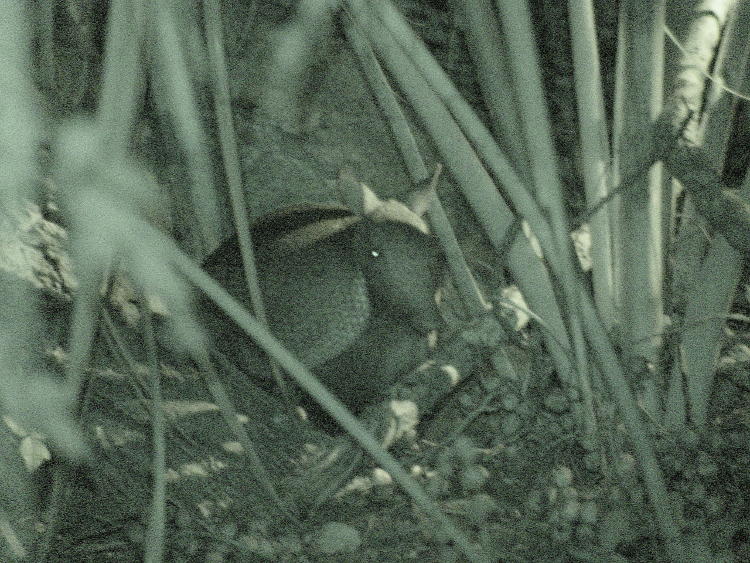
We have reached the Mammals folder again, and thus look in on a nine-banded armadillo (Dasypus novemcinctus) hiding out in the undergrowth at night. And it looks this odd because it was shot with the infra-red option of the Sony F-717. More details of the story can be found here, along with the visible light version of this photo taken only seconds later, but I figured we should take a look at this version.
Most digital sensors are sensitive into the range of infra-red, just outside of the range we can see, and actually have to have filters overlaid within the structure of the camera body to prevent this light from altering the exposure of the image. Yet a few cameras had the ability to shoot solely in infra-red, utilizing some short-range IR LEDS positioned right alongside the lens. These could also be used to allow the camera to autofocus in darkness before the flash was fired for a visible light photo, but as I type this I have to wonder about something. All lenses bend different wavelengths of light to differing degrees, and a lot of engineering has gone into lens arrays for decades to help prevent the visible impact of this, often color fringing; it’s one of the reasons why, when you look into a lens, you might see multi-colored reflections bouncing back to you. And infra-red wavelengths are no different; in fact, older lenses occasionally had an IR marking on the lens to facilitate focusing with this trait. We, naturally, see in visible light, and when a lens was focused sharply for that, it would be out-of-focus in infra-red. So before tripping the shutter with IR film loaded, the photographer would have to adjust the focus by the same margin delineated by the IR mark to bring it into focus at IR wavelengths. So far so good.
And the Sony cameras (and my old Canon Pro-90) could focus and capture IR wavelengths, so no problem there. But the Sonys could also focus in IR, but then fire off the flash and capture the image in visible light. Which should have been out-of-focus. So did that setting compensate for the difference, or what? While framing before tripping the shutter, the image looked perfectly sharp in the LCD viewfinder, so I couldn’t tell you how this worked. The image above might look a bit out-of-focus, but mostly it’s the grain/noise of shooting at an extremely high ISO because infra-red light is pretty weak – look at the reflections from the eyes and the scale pattern of the carapace to realize that this is just low resolution, not bad focus.
By the way, the light you see shining in patches onto the armadillo and its surroundings is not daylight, but the glow from the nearby streetlight over the parking lot of the park where we were, since it was 9:30 PM in May when this was taken fourteen years ago, fully dark. I knew the park at night was a good place to find armadillos, but my brother and I had had a fruitless night trying to spot one before, through the open window of the car, I heard this one digging as we passed. And while this and the other encounter related on that linked page above were memorable, my favorite remains the night I happened across one foraging on the verge at the side of the road, a juvenile scarcely larger than my palm; for some reason, they’re adorable at that size. I might have tried to capture it solely to examine it closely, but it became aware of me before I’d drawn very close and shot off into the brush in an instant. And of course, no camera on me that night. I know, I know, but I was young and foolish…



















































